-
1 of 253523 objects
The Birds of America. Vol. I 1827-30
100.5 x 4.5 cm (book measurement (inventory)) | RCIN 1122502
![The Birds of America, from original drawings ; [v. 1] / by John James Audubon The Birds of America, from original drawings ; [v. 1] / by John James Audubon](https://col.rct.uk/sites/default/files/styles/rctr-scale-1300-500/public/collection-online/4/c/260455-1331137255.jpg?itok=Cd_CB6g5)
After John James Audubon (1785-1851)
The Birds of America, from original drawings ; [v. 1] / by John James Audubon 1827-30
![The Birds of America, from original drawings ; [v. 1] / by John James Audubon The Birds of America, from original drawings ; [v. 1] / by John James Audubon](https://col.rct.uk/sites/default/files/styles/rctr-scale-1300-500/public/collection-online/0/e/260479-1331137408.jpg?itok=pHjIv2qM)
After John James Audubon (1785-1851)
The Birds of America, from original drawings ; [v. 1] / by John James Audubon 1827-30
![The Birds of America, from original drawings ; [v. 1] / by John James Audubon The Birds of America, from original drawings ; [v. 1] / by John James Audubon](https://col.rct.uk/sites/default/files/styles/rctr-scale-1300-500/public/collection-online/f/5/260470-1331137363.jpg?itok=FJvRRZJI)
After John James Audubon (1785-1851)
The Birds of America, from original drawings ; [v. 1] / by John James Audubon 1827-30
![The Birds of America, from original drawings ; [v. 1] / by John James Audubon The Birds of America, from original drawings ; [v. 1] / by John James Audubon](https://col.rct.uk/sites/default/files/styles/rctr-scale-1300-500/public/collection-online/1/b/260478-1331137404.jpg?itok=pkBxucI-)
After John James Audubon (1785-1851)
The Birds of America, from original drawings ; [v. 1] / by John James Audubon 1827-30
![The Birds of America, from original drawings ; [v. 1] / by John James Audubon The Birds of America, from original drawings ; [v. 1] / by John James Audubon](https://col.rct.uk/sites/default/files/styles/rctr-scale-1300-500/public/collection-online/1/3/260477-1331137398.jpg?itok=m4NX-ST-)
After John James Audubon (1785-1851)
The Birds of America, from original drawings ; [v. 1] / by John James Audubon 1827-30
![The Birds of America, from original drawings ; [v. 1] / by John James Audubon The Birds of America, from original drawings ; [v. 1] / by John James Audubon](https://col.rct.uk/sites/default/files/styles/rctr-scale-1300-500/public/collection-online/a/c/260475-1331137391.jpg?itok=D1fz6Zg0)
After John James Audubon (1785-1851)
The Birds of America, from original drawings ; [v. 1] / by John James Audubon 1827-30
![The Birds of America, from original drawings ; [v. 1] / by John James Audubon The Birds of America, from original drawings ; [v. 1] / by John James Audubon](https://col.rct.uk/sites/default/files/styles/rctr-scale-1300-500/public/collection-online/9/8/260473-1331137380.jpg?itok=lKtnCYoF)
After John James Audubon (1785-1851)
The Birds of America, from original drawings ; [v. 1] / by John James Audubon 1827-30
![The Birds of America, from original drawings ; [v. 1] / by John James Audubon The Birds of America, from original drawings ; [v. 1] / by John James Audubon](https://col.rct.uk/sites/default/files/styles/rctr-scale-1300-500/public/collection-online/d/9/260472-1331137376.jpg?itok=RmRnrfc-)
After John James Audubon (1785-1851)
The Birds of America, from original drawings ; [v. 1] / by John James Audubon 1827-30
![The Birds of America, from original drawings ; [v. 1] / by John James Audubon The Birds of America, from original drawings ; [v. 1] / by John James Audubon](https://col.rct.uk/sites/default/files/styles/rctr-scale-1300-500/public/collection-online/1/f/260466-1331137341.jpg?itok=FaCsnECX)
After John James Audubon (1785-1851)
The Birds of America, from original drawings ; [v. 1] / by John James Audubon 1827-30
![The Birds of America, from original drawings ; [v. 1] / by John James Audubon The Birds of America, from original drawings ; [v. 1] / by John James Audubon](https://col.rct.uk/sites/default/files/styles/rctr-scale-1300-500/public/collection-online/a/9/260465-1331137323.jpg?itok=iu8dCpE4)
After John James Audubon (1785-1851)
The Birds of America, from original drawings ; [v. 1] / by John James Audubon 1827-30
![The Birds of America, from original drawings ; [v. 1] / by John James Audubon The Birds of America, from original drawings ; [v. 1] / by John James Audubon](https://col.rct.uk/sites/default/files/styles/rctr-scale-1300-500/public/collection-online/9/2/260464-1331137318.jpg?itok=Jo-ruPkv)
After John James Audubon (1785-1851)
The Birds of America, from original drawings ; [v. 1] / by John James Audubon 1827-30
![The Birds of America, from original drawings ; [v. 1] / by John James Audubon The Birds of America, from original drawings ; [v. 1] / by John James Audubon](https://col.rct.uk/sites/default/files/styles/rctr-scale-1300-500/public/collection-online/b/5/260462-1331137303.jpg?itok=Hw3yN54G)
After John James Audubon (1785-1851)
The Birds of America, from original drawings ; [v. 1] / by John James Audubon 1827-30
![The Birds of America, from original drawings ; [v. 1] / by John James Audubon The Birds of America, from original drawings ; [v. 1] / by John James Audubon](https://col.rct.uk/sites/default/files/styles/rctr-scale-1300-500/public/collection-online/4/2/260459-1331137287.jpg?itok=7GckYWbf)
After John James Audubon (1785-1851)
The Birds of America, from original drawings ; [v. 1] / by John James Audubon 1827-30
![The Birds of America, from original drawings ; [v. 1] / by John James Audubon The Birds of America, from original drawings ; [v. 1] / by John James Audubon](https://col.rct.uk/sites/default/files/styles/rctr-scale-1300-500/public/collection-online/9/8/260458-1331137281.jpg?itok=IcbVahiL)
After John James Audubon (1785-1851)
The Birds of America, from original drawings ; [v. 1] / by John James Audubon 1827-30
![The Birds of America, from original drawings ; [v. 1] / by John James Audubon The Birds of America, from original drawings ; [v. 1] / by John James Audubon](https://col.rct.uk/sites/default/files/styles/rctr-scale-1300-500/public/collection-online/f/c/260457-1331137275.jpg?itok=Jx21Cwfg)
After John James Audubon (1785-1851)
The Birds of America, from original drawings ; [v. 1] / by John James Audubon 1827-30
![The Birds of America, from original drawings ; [v. 1] / by John James Audubon The Birds of America, from original drawings ; [v. 1] / by John James Audubon](https://col.rct.uk/sites/default/files/styles/rctr-scale-1300-500/public/lead-image/trail/260456-1331137264.jpg?itok=MYZs6AfS)
After John James Audubon (1785-1851)
The Birds of America, from original drawings ; [v. 1] / by John James Audubon 1827-30
![The Birds of America, from original drawings ; [v. 1] / by John James Audubon The Birds of America, from original drawings ; [v. 1] / by John James Audubon](https://col.rct.uk/sites/default/files/styles/rctr-scale-1300-500/public/collection-online/7/d/260454-1331137250.jpg?itok=R9izpPd0)
After John James Audubon (1785-1851)
The Birds of America, from original drawings ; [v. 1] / by John James Audubon 1827-30
![The Birds of America, from original drawings ; [v. 1] / by John James Audubon The Birds of America, from original drawings ; [v. 1] / by John James Audubon](https://col.rct.uk/sites/default/files/styles/rctr-scale-1300-500/public/collection-online/8/8/260453-1331137244.jpg?itok=rifF2kVt)
After John James Audubon (1785-1851)
The Birds of America, from original drawings ; [v. 1] / by John James Audubon 1827-30
![The Birds of America, from original drawings ; [v. 1] / by John James Audubon The Birds of America, from original drawings ; [v. 1] / by John James Audubon](https://col.rct.uk/sites/default/files/styles/rctr-scale-1300-500/public/collection-online/3/e/260451-1331137226.jpg?itok=7ydVMgQ6)
After John James Audubon (1785-1851)
The Birds of America, from original drawings ; [v. 1] / by John James Audubon 1827-30
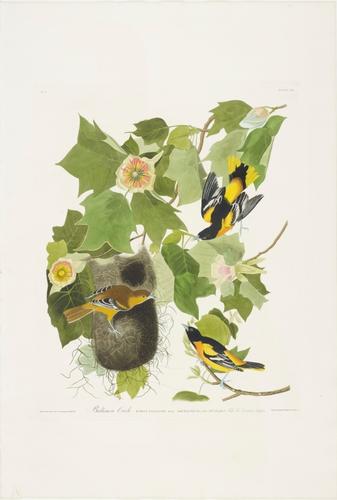
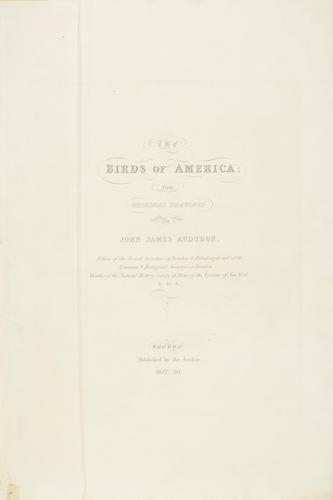
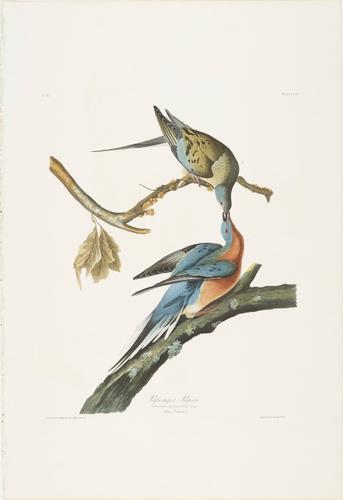

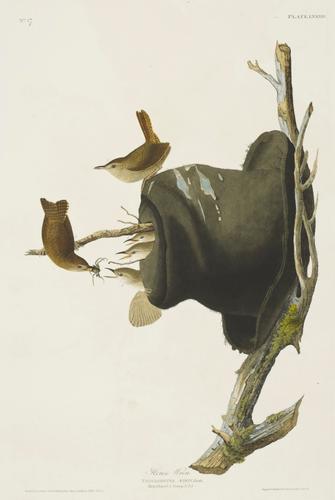
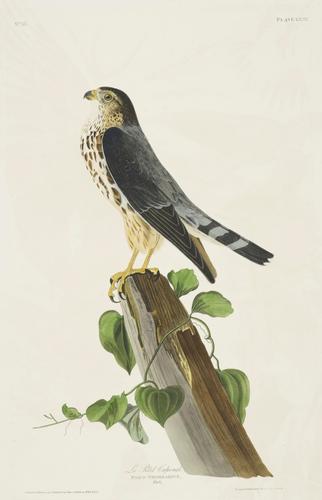
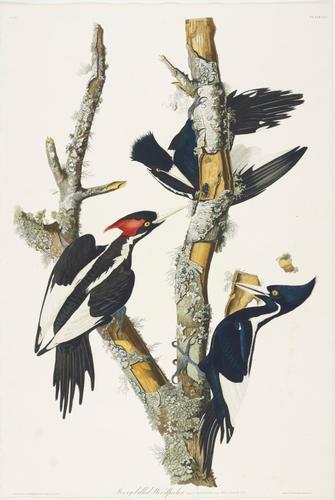
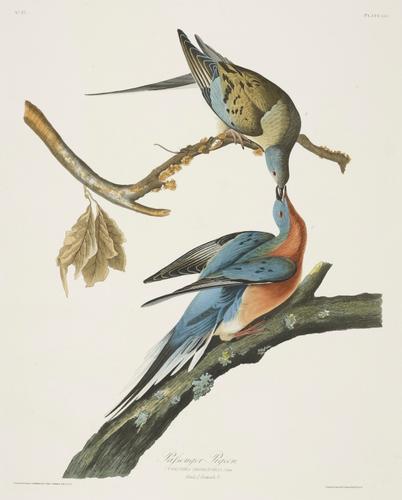
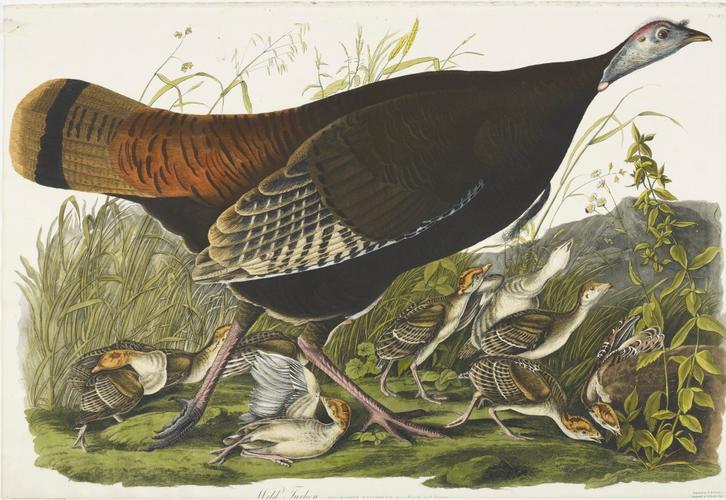
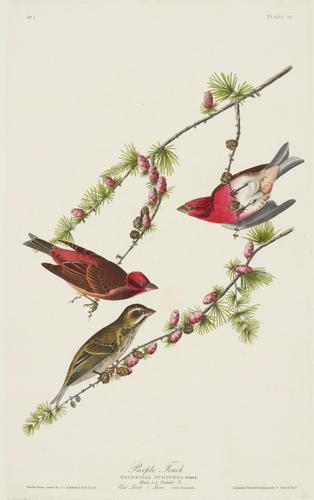
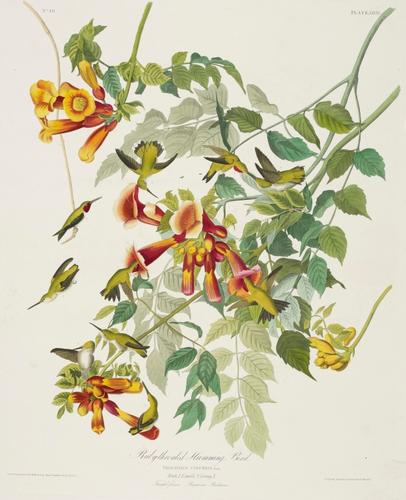
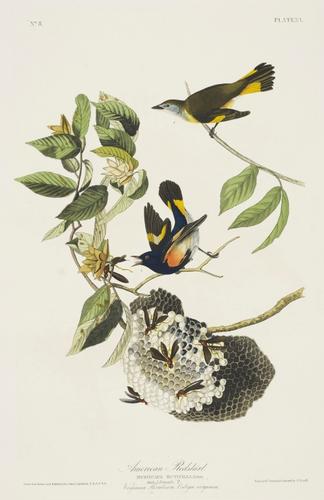
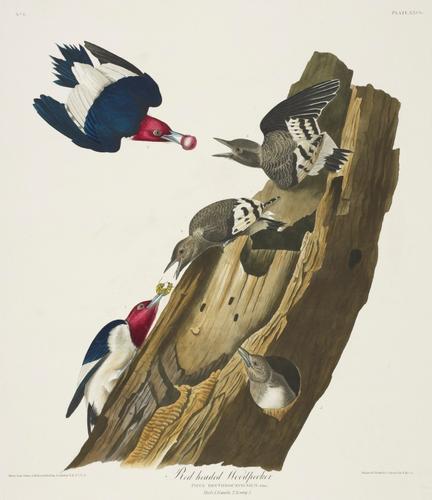
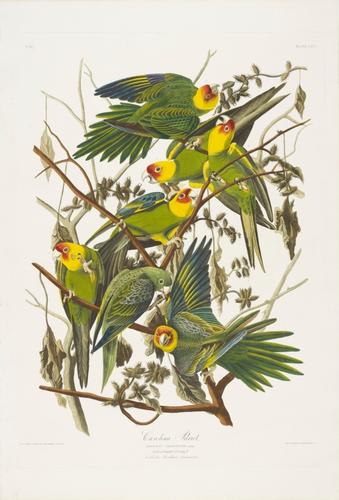
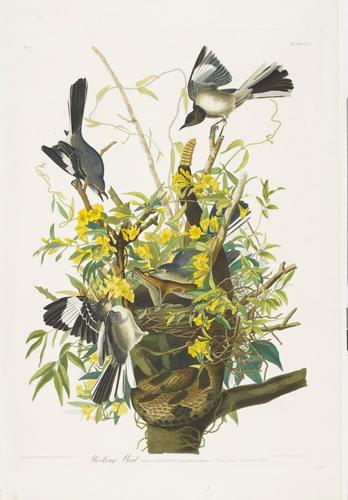

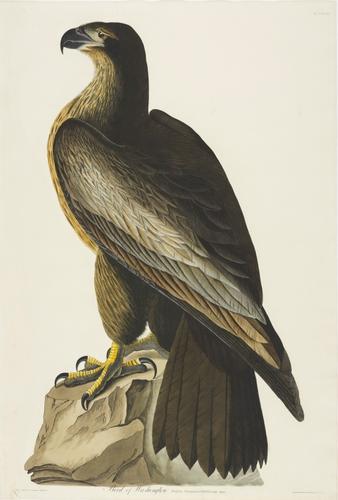
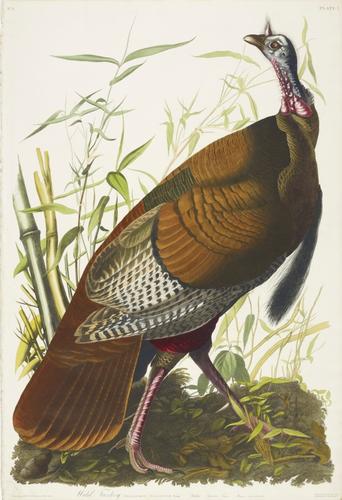
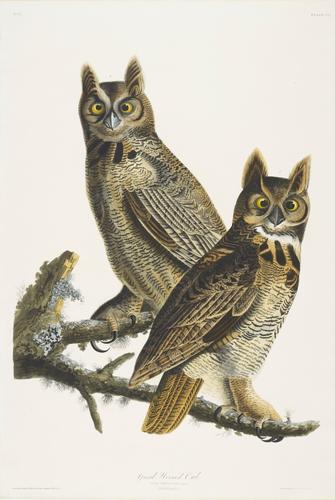
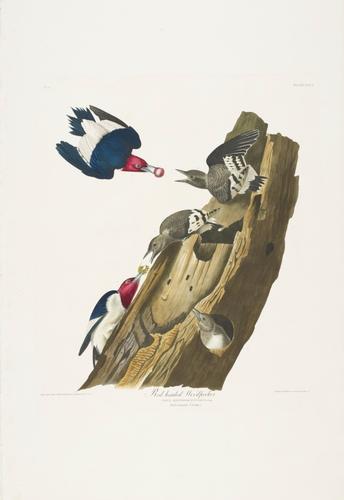
-
John James Audubon (1785-1851) was a self-taught artist specialising in ornithological (bird) paintings and is most famous for his magnificent double-elephant folio, The Birds of America, published between 1827 and 1838, which consists of 435 hand-coloured plates.
Audubon was born on the island of Hispaniola in the French colony of Saint-Domingue (now Haiti), where his father owned a plantation and profited from the use of enslaved labour. Having spent much of his childhood in France, in 1803, he was sent to Philadelphia by his father to manage a farm purchased, unseen, at an auction. Audubon was little interested in management and spent much of his time drawing, observing and collecting birds. In 1807 he sold the farm and moved to Louisville, Kentucky, where he took up ownership of a general store, again bought by his father. Selling the store in 1810, Audubon undertook an expedition along the Ohio and Mississippi rivers, collecting and drawing the birds he found there.
In 1812, almost a thousand of his drawings were lost when a family of rats shredded them to make nests. This unfortunate accident gave him the impetus to make better drawings and watercolours than he had done previously. That same year Audubon gained American citizenship and spent much of the next decade managing a farm and flour mill. The estate was worked by enslaved people and Audubon profited directly from their labour until a financial crash in 1819 led to a declaration of bankruptcy and his imprisonment. Audubon not only profited from the ownership of enslaved people, he also opposed increasing calls for the abolition of slavery in the United States in the first half of the nineteenth century.
Following his bankruptcy, Audubon embarked on his project to produce the most magnificent bird book ever published. Aided by his wife and sons, Audubon made several expeditions to hunt and draw birds, and, in 1824, he travelled to Philadelphia to try to get his paintings published. In Philadelphia, there was little interest in such an undertaking, Alexander Wilson's American Ornithology (9 vols, 1808-14) had recently been published and another edition was already in production. Audubon also had few scientific credentials and was unknown among the academic community.
In 1826, he travelled to Britain in the hope of better luck, first arriving in Liverpool before travelling to Edinburgh and eventually London. In Britain, Audubon was a natural showman, dressed in his frontier clothes, his watercolours strapped to his back, he regaled social circles with tales of his travels and his encounters with Native Americans, gaining a reputation across the country as the "American Woodsman".
Gradually gaining a few subscribers – 151 in total, including George IV – Audubon gained the support of the engraver Robert Havell (1793-1878) to produce hand-coloured engravings of his watercolours. The work was ambitious; The Birds of America was to be printed in double-elephant folio, the same size as Audubon's original drawings, ensuring that the largest birds were depicted life-size, while the subtle use of foliage ensured that smaller birds did not look out of place in the largest plates.
The Birds of America was an innovative work: unlike contemporary bird books, the birds were depicted as if alive, either hunting, preening, perched or in flight. Ornithologists, until the invention of prism binoculars in the mid-nineteenth century, often drew birds that had been shot and stuffed. Audubon mounted his specimens on wires and arranged them into life-like positions in front of a grid that enabled him to maintain proportions. Scientifically, the positions in which Audubon posed his birds are rather curious and not absolutely true to life, but as paintings, the innovations produced spectacular results.
The plates were issued to subscribers in groups of five, one image in each group filling the double-elephant sheet, one occupying most of the sheet and three smaller images. Unfortunately, due to the size and cost of such a lavish work, there was very little profit and smaller octavo editions were published in the 1840s with lithographs and marketed towards those who could not afford the larger edition. An accompanying five-volume letterpress, edited by the Scottish ornithologist William MacGillivray (1796-1852), followed in 1831-9 (see RCINs 1055640-4).
Only around 120 of the 151 completed double-elephant editions survive in their entirety. Bills in the Royal Archives show that George IV received the first plates in March 1828 (RA GEO/MAIN/28895). On his death, his subscription appears to have continued before subsequently passing to Queen Victoria, who had the loose plates bound in four volumes. The bound volumes of the copy now in the Royal Library were first recorded in the 1843 catalogue of the Queen's private library at Buckingham Palace. It was once rumoured that George's subscription had passed to Queen Adelaide, the consort of William IV, as her name was also listed among Audubon's subscribers. However, in 2004, the emergence and sale of her incomplete unbound copy, known as the 'Saxe-Meiningen copy', so named after the Princely house to which she belonged, put an end to the theory.Provenance
Subscription started by George IV, receiving first 16 numbers (80 plates in total) between March 1828 and December 1829. First bound during the reign of Queen Victoria.
-
Creator(s)
(engraver)(publisher)Acquirer(s)
-
Measurements
100.5 x 4.5 cm (book measurement (inventory))
Category
Alternative title(s)
The Birds of America, from original drawings ; [v. 1] / by John James Audubon.